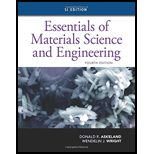
(a)
Interpretation:
The temperature at which austenite begins to transform needs to be determined.
Concept Introduction:
Austenite is defined as a gamma-phase iron, it is a metallic, non-magnetic iron allotrope or a solid solution of iron, containing an alloying element. Austenite which is known to exist above the eutectoid temperature of 1000K of plain carbon steel. Other alloys of the steel contain different eutectoid temperatures. Austenite can remain stable at room temperature only in the presence of austenite stability elements, e.g. Ni in adequate quantity.
Answer to Problem 12.63P
The temperatutre at which austenite will transform in Fe-
Explanation of Solution
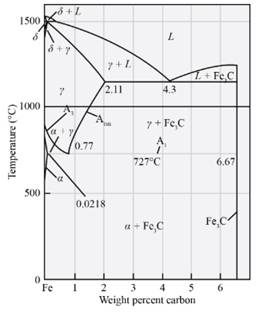
From the diagram cited above, the temperature at which austenite will start transforming on cooling in the Fe
(b)
Interpretation:
The primary microconstituents that are formed needs to be determined.
Concept Introduction:
The microconstituent of iron carbide includes austenite (
Answer to Problem 12.63P
The primary micro constituents that is formed in the alloy is primary Fe3C.
Explanation of Solution
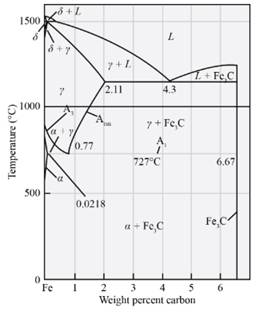
From the diagram mentioned above the microconstituent which is formed in the Fe-
(c)
Interpretation:
The amount and composition of phase at
Concept Introduction:
The plain iron-carbon alloys contain the amount of steel between 0.002% and 2.14 % by weight. At atmospheric pressure, the phases of iron plays a vital role because of the differences in carbon which forms different types of steel. High pressure phases of iron are significant as the prototype of the solid parts regarding planetary cores. The standard pressure phases are as follows:
1) Delta iron
2) Gamma iron/ austenite
3) Beta iron
4) Alpha iron
Answer to Problem 12.63P
The amount and composition of phases in Fe-
Explanation of Solution
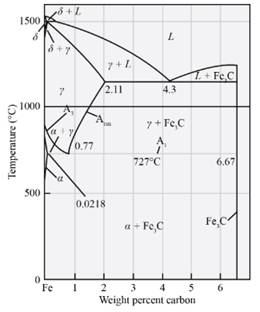
Draw a line at which passes through Fe3Cand ofFe3C and r.
(d)
Interpretation:
The amount and composition of phases at
Concept Introduction:
The plain iron-carbon alloys contain the amount of steel between 0.002% and 2.14 % by weight. At atmospheric pressure, the phases of iron plays a vital role because of the differences in carbon which forms different types of steel. High pressure phases of iron are significant as the prototype of the solid parts regarding planetary cores. The standard pressure phases are as follows:
1) Delta iron
2) Gamma iron/ austenite
3) Beta iron
4) Alpha iron
Answer to Problem 12.63P
The amount and composition of phases at
Explanation of Solution
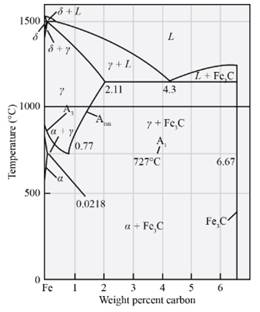
Based on the digram we have the formula as mentioned above,
(e)
Interpretation:
The amount and composition of microconstituent at
Concept Introduction:
The plain iron-carbon alloys contain the amount of steel between 0.002% and 2.14 % by weight. At atmospheric pressure, the phases of iron plays a vital role because of the differences in carbon which forms different types of steel. High pressure phases of iron are significant as the prototype of the solid parts regarding planetary cores. The standard pressure phases are as follows:
1) Delta iron
2) Gamma iron/ austenite
3) Beta iron
4) Alpha iron
Answer to Problem 12.63P
The amount and composition of microconstituent are
Explanation of Solution
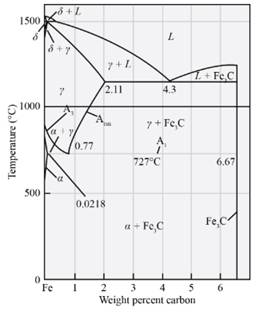
Based on the diagram mentioned above the microconstituent whichare present in the alloy at
The amount of primary Fe3C and composition are as follows:
Primary Fe3C=
% primary Fe3C=
The amount and composition of pearlite are:
Pearlite=
% pearlite=
Want to see more full solutions like this?
Chapter 12 Solutions
Essentials Of Materials Science And Engineering, Si Edition
- Refer to the figure below. Given: L = 7 m, y = 16.7 kN/m², and ø' = 30°. L L3 ση Sand γ $' D T LA L σε σε IN P Sand 1. Calculate the theoretical depth of penetration, D. (Enter your answer to three significant figures.) D= m 2. Calculate the maximum moment. (Enter your answer to three significant figures.) Mmax kN-m/marrow_forwardChemical Engineering Use the psychrometric chart and demonstrate the linear interpolation method to obtain -0.52 KJ/KgDA. This is the enthalpy deviation. The exercise is uploaded below.arrow_forwardChemical Engineering Use the psychrometric chart. The remaining curves on the psychrometric chart are almost vertical and convex to the left, with labeled values (on Figure 8.4-1) of 0.05, 0.1, 0.2, and so on. (The units of these numbers arekJ/kg DA). Thesecurves are usedto determine theenthalpyof humid air that is not saturated. The procedure is as follows: (a) locate the point on the chart corresponding to air at its specified condition; (b) interpolate to estimate the enthalpy deviation at this point; (c) follow the constant wet-bulb temperature line to the enthalpy scale above the saturation curve, read the value on that scale, and add the enthalpy deviation to it. Also, you will see the exercise on the piece of paper.arrow_forward
- Why is it important for construction project managers to be flexible when dealing with the many variable factors that pop up in a project?arrow_forwardFind the valve of the voltage Vx using the THEVENIN equivalent circuit and redo the problem with the NORTON equivalent circuit. Show both the the vinen and Norton circuits. I 12V m 1 ww 3 23 + 43Vx 5 63 миarrow_forwardthe nagle algorithm, built into most tcp implementations, requires the sender to hold a partial segment's worth of data (even if pushed) until either a full segment accumulates or the most recent outstanding ack arrives. (a) suppose the letters abcdefghi are sent, one per second, over a tcp connection with an rtt of 4.1 seconds. draw a timeline indicating when each packet is sent and what it contains.arrow_forward
- Find the valve of V using the Thevenin Equivalent Circuit and then determine if the 8 ohm resistor allows maximum power transfer. If not, then what value should the 8 ohm resistor be changed to for maximum power transfer? ZA 6 6 + 22V 83 V 34 2 6 АААА ААААarrow_forwardComplete the following problems. Show your work/calculations, save as.pdf and upload to the assignment in Blackboard. missing information to present a completed program. (Hint: You may have to look up geometry for the center drill and standard 0.5000 in twist drill to know the required depth to drill). 1. What are the x and y dimensions for the center position of holes 1,2, and 3 in the part shown in Figure 26.2 (below)? 6.0000 Zero reference point 7118 1.0005 1.0000 1.252 Bore 6.0000 .7118 Cbore 0.2180 deep (3 holes) 2.6563 1.9445 Figure 26.2 026022 (8lot and Drill Part) (Setup Instructions--- (UNITS: Inches (WORKPIECE NAT'L SAE 1020 STEEL (Workpiece: 3.25 x 2.00 x0.75 in. Plate (PRZ Location 054: ' XY 0.0 - Upper Left of Fixture TOP OF PART 2-0 (Tool List ( T02 0.500 IN 4 FLUTE FLAT END MILL #4 CENTER DRILL Dashed line indicates- corner of original stock ( T04 T02 3.000 diam. slot 0.3000 deep. 0.3000 wide Intended toolpath-tangent- arc entry and exit sized to programmer's judgment…arrow_forwardFind the valve of voltage Vx using the THE VIN IN equivalent circuit ww 8 Show the Theven in Circuit. I 7V ZV m 6 5 M + 4 34 АА 3 1 АААА 9A ↑ 24arrow_forward
- What are some reasons for why a company would accelerate a construction project?arrow_forwardA program to make the part depicted in Figure 26.A has been created, presented in figure 26.B, but some information still needs to be filled in. Compute the tool locations, depths, and other missing information to present a completed program. (Hint: You may have to look up geometry for the center drill and standard 0.5000 in twist drill to know the required depth to drill).arrow_forwardDon't use ai to answer I will report you answerarrow_forward
 MATLAB: An Introduction with ApplicationsEngineeringISBN:9781119256830Author:Amos GilatPublisher:John Wiley & Sons Inc
MATLAB: An Introduction with ApplicationsEngineeringISBN:9781119256830Author:Amos GilatPublisher:John Wiley & Sons Inc Essentials Of Materials Science And EngineeringEngineeringISBN:9781337385497Author:WRIGHT, Wendelin J.Publisher:Cengage,
Essentials Of Materials Science And EngineeringEngineeringISBN:9781337385497Author:WRIGHT, Wendelin J.Publisher:Cengage, Industrial Motor ControlEngineeringISBN:9781133691808Author:Stephen HermanPublisher:Cengage Learning
Industrial Motor ControlEngineeringISBN:9781133691808Author:Stephen HermanPublisher:Cengage Learning Basics Of Engineering EconomyEngineeringISBN:9780073376356Author:Leland Blank, Anthony TarquinPublisher:MCGRAW-HILL HIGHER EDUCATION
Basics Of Engineering EconomyEngineeringISBN:9780073376356Author:Leland Blank, Anthony TarquinPublisher:MCGRAW-HILL HIGHER EDUCATION Structural Steel Design (6th Edition)EngineeringISBN:9780134589657Author:Jack C. McCormac, Stephen F. CsernakPublisher:PEARSON
Structural Steel Design (6th Edition)EngineeringISBN:9780134589657Author:Jack C. McCormac, Stephen F. CsernakPublisher:PEARSON Fundamentals of Materials Science and Engineering...EngineeringISBN:9781119175483Author:William D. Callister Jr., David G. RethwischPublisher:WILEY
Fundamentals of Materials Science and Engineering...EngineeringISBN:9781119175483Author:William D. Callister Jr., David G. RethwischPublisher:WILEY





